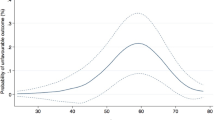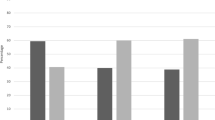Abstract
Previous studies have shown discrepancies among countries in terms of treatment indications and patients’ management due to different health care policies. Penile prosthesis implantation (PPI) is a highly effective treatment for erectile dysfunction (ED), which may have different accessibility according to the type of health system. We compared clinical characteristics of patients included in two national registries on PPI to investigate the influence of different health care systems on treatment indication and accessibility. The multicenter Italian Nationwide Systematic Inventarization of Surgical Treatment for ED (INSIST-ED) Registry and the multicenter Prospective Registry of Outcomes with Penile Prosthesis for Erectile Restoration (PROPPER), respectively for Italy and North America were considered. Clinical characteristics of patients included in both registries were compared using Wilcoxon Rank Sum test and the Pearson’s Chi square test. Patients submitted to PPI in Italy are significantly younger (age: 61.2 vs. 63.8 years; p ≤ 0.001) compared with North America. The majority of patients are treated for post-radical prostatectomy ED in both registries (Italy: 31%; North America: 27%), although diabetes and cardiovascular diseases are more frequent reasons for PPI in the PROPPER registry (p ≤ 0.001), reflecting differences in disease prevalence among countries. In North America a non-hydraulic implant is considered only in 1% of cases as compared with 3% in Italy (p ≤ 0.001). In terms of postoperative management, a compressive surgical dressing (98% vs. 24%; p ≤ 0.001) is a more common strategy in North America. Finally, in Italy most surgeries are performed in a public hospital (82%), while the private setting (70.8%) is more common in North America (p ≤ 0.001). These findings suggest differences in health care systems between Italy and North America. A system like the American one would guarantee easier access to PPI in countries where the National Health System is mainly based on reimbursement to public hospital settings and where patients choosing private settings have to pay by themselves.
This is a preview of subscription content, access via your institution
Access options
Subscribe to this journal
Receive 8 print issues and online access
$259.00 per year
only $32.38 per issue
Buy this article
- Purchase on Springer Link
- Instant access to full article PDF
Prices may be subject to local taxes which are calculated during checkout
Similar content being viewed by others
References
European Association of Urology Guidelines on Male Sexual Dysfunctions. 2019. https://uroweb.org/guideline/male-sexual-dysfunction/.
Bernal RM, Henry GD. Contemporary patient satisfaction rates for three-piece inflatable penile prostheses. Adv Urol. 2012;2012:707321.
Pillay B, Moon D, Love C, Meyer D, Ferguson E, Crowe H, et al. Quality of life, psychological functioning, and treatment satisfaction of men who have undergone penile prosthesis surgery following robot-assisted radical prostatectomy. J Sex Med. 2017;14:1612–20.
Pescatori E, Alei G, Antonini G, Avolio A, Bettocchi C, Bitelli M, et al. INSIST-ED: Italian Society of Andrology registry on penile prosthesis surgery. First data analysis. Arch Ital Urol Androl. 2016;88:122–7.
Capogrosso P, Pescatori E, Caraceni E, Mondaini N, Utizi L, Cai T, et al. Satisfaction rate at 1-year follow-up in patients treated with penile implants: data from the multicentre prospective registry INSIST-ED. BJU Int. 2019;123:360–6.
Henry GD, Karpman E, Brant W, Christine B, Kansas BT, Khera M, et al. The who, how and what of real-world penile implantation in 2015: the PROPPER registry baseline data. J Urol. 2016;195:427–33.
Karthikesalingam A, Vidal-Diez A, Holt PJ, Loftus IM, Schermerhorn ML, Soden PA, et al. Thresholds for abdominal aortic aneurysm repair in England and the United States. N Engl J Med. 2016;375:2051–9.
Bennett N, Henry G, Karpman E, Brant W, Jones L, Khera M, et al. Inflatable penile prosthesis implant length with baseline characteristic correlations: preliminary analysis of the PROPPER study. Transl Androl Urol. 2017;6:1167–74.
Khera M, Bella A, Karpman E, Brant W, Christine B, Kansas B, et al. Penile prosthesis implantation in patients with peyronie’s disease: results of the PROPPER study demonstrates a decrease in patient-reported depression. J Sex Med. 2018;15:786–8.
Laslett LJ, Alagona P Jr, Clark BA 3rd, Drozda JP Jr, Saldivar F, Wilson SR, et al. The worldwide environment of cardiovascular disease: prevalence, diagnosis, therapy, and policy issues: a report from the American College of Cardiology. J Am Coll Cardiol. 2012;60 25 Suppl :S1–49.
Ogurtsova K, da Rocha Fernandes JD, Huang Y, Linnenkamp U, Guariguata L, Cho NH, et al. IDF Diabetes Atlas: Global estimates for the prevalence of diabetes for 2015 and 2040. Diabetes Res Clin Pract. 2017;128:40–50.
Rodriguez KM, Kohn TP, Davis AB, Hakky TS. Penile implants: a look into the future. Transl Androl Urol. 2017;6 Suppl 5 :S860–6.
Alwaal A, Harris CR, Hussein AA, Sanford TH, McCulloch CE, Shindel AW, et al. The decline of inpatient penile prosthesis over the 10-year period, 2000–2010. Sex Med. 2015;3:280–6.
Levine LA, Becher E, Bella A, Brant W, Kohler T, Martinez-Salamanca JI, et al. Penile prosthesis surgery: current recommendations from the International Consultation on Sexual Medicine. J Sex Med. 2016;13:489–518.
Acknowledgements
PROPPER Prospective Registry of Outcomes With Penile Prosthesis (PROPPER). Anthony J. Bella, MD University of Ottawa. LeRoy Jones, MD Urology San Antonio Research PA. Bryan T Kansas, MD The Urology Team. Brian Christine, MD Urology Centers of Alabama. Kevin McVary, MD SIU School of Medicine. James Hotaling, MD University of Utah. Mohit Khera, MD Baylor College of Medicine, Eugene Rhee, MD Kaiser Permanente.
INSIST-ED study group
Giovanni Alei12, Gabriele Antonini12, Antonio Avolio13, Marco Bitelli14, Francesco Boezio15, Tommaso Cai16, Enrico Caraceni17, Maurizio Carrino18, Enrico Conti19, Antonio Corvasce20, Nicola Ghidini4, Emilio Italiano21, Giuseppe La Pera22, Alessandro Natali23, Carlo Negro24, Fabrizio Palumbo6, Matteo Paradiso24, Massimo Polito25, Diego Pozza26, Mauro Silvani27, Aldo Tamai28, Massimiliano Timpano29, Lilia Utizi17, Francesco Varvello30, Patrizio Vicini31, Antonio Vitarelli6, Giorgio Franco12
Author information
Authors and Affiliations
Consortia
Corresponding author
Ethics declarations
Conflict of interest
The authors declare that they have no conflict of interest.
Additional information
Publisher’s note Springer Nature remains neutral with regard to jurisdictional claims in published maps and institutional affiliations.
Members of the INSIST-ED study group are listed below Acknowledgements
Rights and permissions
About this article
Cite this article
Deho’, F., Henry, G., Karpman, E. et al. Comparing the Italian and North American prospective registries on penile prosthesis surgery: are there relevant differences in treatment indications and patients’ management?. Int J Impot Res 33, 563–567 (2021). https://doi.org/10.1038/s41443-020-0318-5
Received:
Accepted:
Published:
Issue Date:
DOI: https://doi.org/10.1038/s41443-020-0318-5



